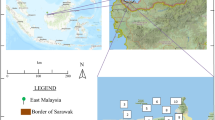Abstract
The Chaohu is one of the largest five freshwater lakes in China. It provides freshwater for agriculture, life, and part of industry. The quality of water becomes worst and worst due to the toxic matter. In this study, we collected the samples from the sedimentary mud in the lake. The distribution of some potential hazardous trace elements (Cu, Ni, Cr, As, Pb, Cd, and Hg) in the sediments of western Chaohu Lake, has been determined and studied, and the enrichment factors, the index of geoaccumulation, and potential ecological risk were analyzed and calculated. The results show that: the levels of selected potential hazardous trace element vary from different sampling sites and significant anthropogenic impact of Pb and Cd occur in sediments. The contamination rank of Pb and Cd are moderate, and Pb has a light potential ecological risk, but Cd is heavy. The total potential ecological risk of the selected hazardous trace elements in this study in Chaohu Lake is moderate. Cluster and correlation analysis indicate that the selected potential hazardous trace element pollutant has different source and co-contamination also occur in sediments.
Similar content being viewed by others
References
Audry, S., Schäfer, J., Blanc, G., et al. (2004). Fifty-year sedimentary record of heavy metal pollution (Cd, Zn, Cu, Pb) in the Lot River reservoirs (France). Environmental Pollution, 132(3), 413–426. doi:10.1016/j.envpol.2004.05.025.
Cao, D. J., Yue, Y. D., Huang, X. M., et al. (2004). Environmental quality assessment of Pb, Cu, Fe pollution in Chaohu Lake waters. China Environmental Science, 24(4), 509–512 (in Chinese with English abstract).
Chen, H., & Wang, J. (1999). Endangerment and control strategy of eutrophication of Chaohu Lake. Chinese Journal of Hefei University Technology, 22(S1), 63–66 (in Chinese with English abstract).
Covelli, S., & Fontolan, G. (1997). Application of a normalization procedure in determining regional geochemical baselines. Environmental Geology, 30, 34–45. doi:10.1007/s002540050130.
Förstner, U., & Whitman, G. T. W. (1981). Metal pollution in the aquatic environment (p. 486). Berlin: Springer.
Hakanson, L. (1980). An ecological risk index for aquatic pollution control, a sedimentological approach. Water Research, 14, 975–1002. doi:10.1016/0043-1354(80)90143-8.
Han, W. Y., Zhao, F. J., Shi, Y. Z., et al. (2006a). Scale and causes of lead contamination in Chinese tea. Environmental Pollution, 139(1), 125–132. doi:10.1016/j.envpol.2005.04.025.
Han, X. R. (1998). A case study on water quality in Chaohu Lake. Chinese Journal of Water Resource Protection, 24, 153–156 (in Chinese with English abstract).
Han, Y. M., Du, P. X., Cao, J. J., et al. (2006b). Multivariate analysis of heavy metal contamination in urban dusts of Xi’an, Central China. The Science of the Total Environment, 355(1–3), 176–186. doi:10.1016/j.scitotenv.2005.02.026.
Ji, Y. Q., Feng, Y. C., Wu, J. H., et al. (2008). Using geoaccumulation index to study source profiles of soil dust in China. Journal of Environmental Sciences (China), 20, 571–578. doi:10.1016/S1001-0742(08)62096-3.
Jin, C. W., He, Y. F., Zhang, K., et al. (2005). Lead contamination in tea leaves and non-edaphic factors affecting it. Chemosphere, 61(5), 726–732. doi:10.1016/j.chemosphere.2005.03.053.
Li, Y. H. (1981). Geochemical cycles of elements and human perturbation. Geochimica et Cosmochimica Acta, 45, 2073–2084. doi:10.1016/0016-7037(81)90061-2.
Loska, K., Cebula, J., & Pelczar, J. (1997). Use of enrichment, and contamination factors together with geoaccumulation indexes to evaluate the content of Cd, Cu, and Ni in the Rybnik Water Reservoir in Poland. Water, Air, & Soil Pollution, 93, 347.
Loska, K., Wiechula, D., Barska, B., et al. (2003). Assessment of arsenic enrichment of cultivated soils in southern Poland. Polish Journal of Environmental Studies, 12(2), 187–192.
Muniz, P., Venturini, N., & Gómez-erache, M. (2004). Spatial distribution of chromium and lead in the benthic environment of coastal areas of the RÍO DE LA plata estuary (Montevideo, Uruguay). Brazilian Journal of Biology, 64(1), 103–116. doi:10.1590/S1519-69842004000100012.
Sinex, S. A., & Wright, D. A. (1988). Distribution of trace metals in the sediments and biota of Chesapeake Bay. Marine Pollution Bulletin, 19, 425–431. doi: 10.1016/0025-326X(88)90397-9.
Slobodan, M., Goran, D., & Esad, P. (1999). Evalution of terra rossa geochemical baselines from Croatian karst regions. Journal of Geochemical Exploration, 66, 173–182. doi:10.1016/S0375-6742(99)00010-2.
Susana, O. R., Daniel, dela R., Lazaro, L., et al. (2005). Assessment of heavy metal levels in Almendares River sediments-Havana City, Cuba. Water Research, 39, 3945–3953.
Sutherland, R. A. (2000). Bed sediment-associated trace metals in and urban stream, Oahu, Hawaii. Environmental Geology, 39(6), 611–627. doi:10.1007/s002540050473.
Szefer, P., Fowler, S. W., Ikuta, K., et al. (2006). A comparative assessment of heavy metal accumulation in soft parts and byssus of mussels fro subbarctic, temperate, subtropical and tropical marine environments. Environmental Pollution, 139(1), 70–78. doi:10.1016/j.envpol.2005.04.031.
Trefry, J. H., & Presley, B. J. (1976). Heavy metals in sediments from San Antonio Bay and the northwest Gulf of Mexico. Environmental Geology, 1, 282–294. doi:10.1007/BF02676717.
Tu, H., Gu, D., Yin, C., et al. (1990). Chaohu Lake-study on eutrophication (pp. 1–226). Hefei, China: University of China Science and Technology Press (in Chinese).
Turekian, K. K., & Wedepohl, K. H. (1961). Distribution of the elements in some major units of the earth’s crust. Bulletin of the Geological Society of America, 72, 175–192. doi:10.1130/0016-7606(1961)72[175:DOTEIS]2.0.CO;2.
Wang, Y. H., Liu, Z. Y., Liu, W., et al. (2003). Distribution and correlation characteristics between pollutants in sediment in Chaohu Lake, China. Acta Scientiarum Naturalium Universitatis Pekinensis, 39(4), 501–506.
Xu, M. Q., Cao, H., Xie, P., et al. (2005). Use of PFU protozoan community structural and functional characteristics in assessment of water quality in a large, highly polluted freshwater lake in China. Journal of Environmental Monitoring, 7, 670–674. doi:10.1039/b504396b.
Yin, C., & Bernhardt, K. (1992). Ecological effects of pollution in Chaohu Lake, China. Journal of Environmental Science(China)-Special Issue, 4(2), 1–128.
Author information
Authors and Affiliations
Corresponding author
Rights and permissions
About this article
Cite this article
Zheng, LG., Liu, GJ., Kang, Y. et al. Some potential hazardous trace elements contamination and their ecological risk in sediments of western Chaohu Lake, China. Environ Monit Assess 166, 379–386 (2010). https://doi.org/10.1007/s10661-009-1009-3
Received:
Accepted:
Published:
Issue Date:
DOI: https://doi.org/10.1007/s10661-009-1009-3




